FARM TO TABLE
Sugar, South Africa’s sweet spot
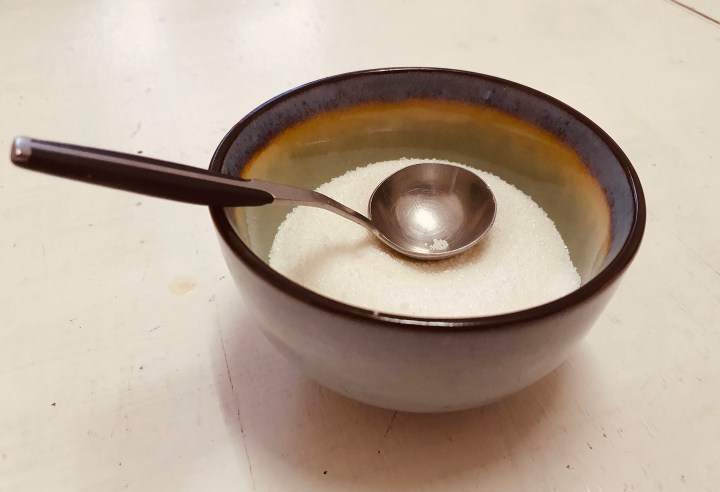
If you understand how it works, sugar can make you a magician... even if it’s just with that extra ‘bietjie vir liefde’ that you add to your loved one’s morning coffee.
Sugar – our evolutionary weakness. Since the beginning of time, humans have been seeking out sweet, calorie-packed morsels to keep us alive. In nature, it’s found in the purest form in most fruit and vegetables. From avocados and bananas to xigua, youngberries and zucchini, sugar is a well-represented and healthy addition to any diet. However, as the evolution of our collective South African midriff suggests, we prefer it more refined. Did you know South Africans are the most obese nation, this side of the Sahara?
Oh, but the sweet joy of sugar… Few things rival the simple delight of crunchy, undissolved white sugar over warm “umphokoqo”. Or the sticky goodness of “soetwortels”, rescued from the edge of over-caramelisation with an expert eye. Church bazaars and agricultural fairs won’t be the same without “spookasem”, “tamaletjies” or bright green and red sugar-glazed toffee apples on sale. And would sweet, black “Boeretroos” even be of any comfort to farmers without at least three heaps of white sugar? Certainly not.
The mere existence of the purpose-built “suikerlepel” – which should always be the size of a small shovel – is a clear indicator of how important sugar is to South Africans.
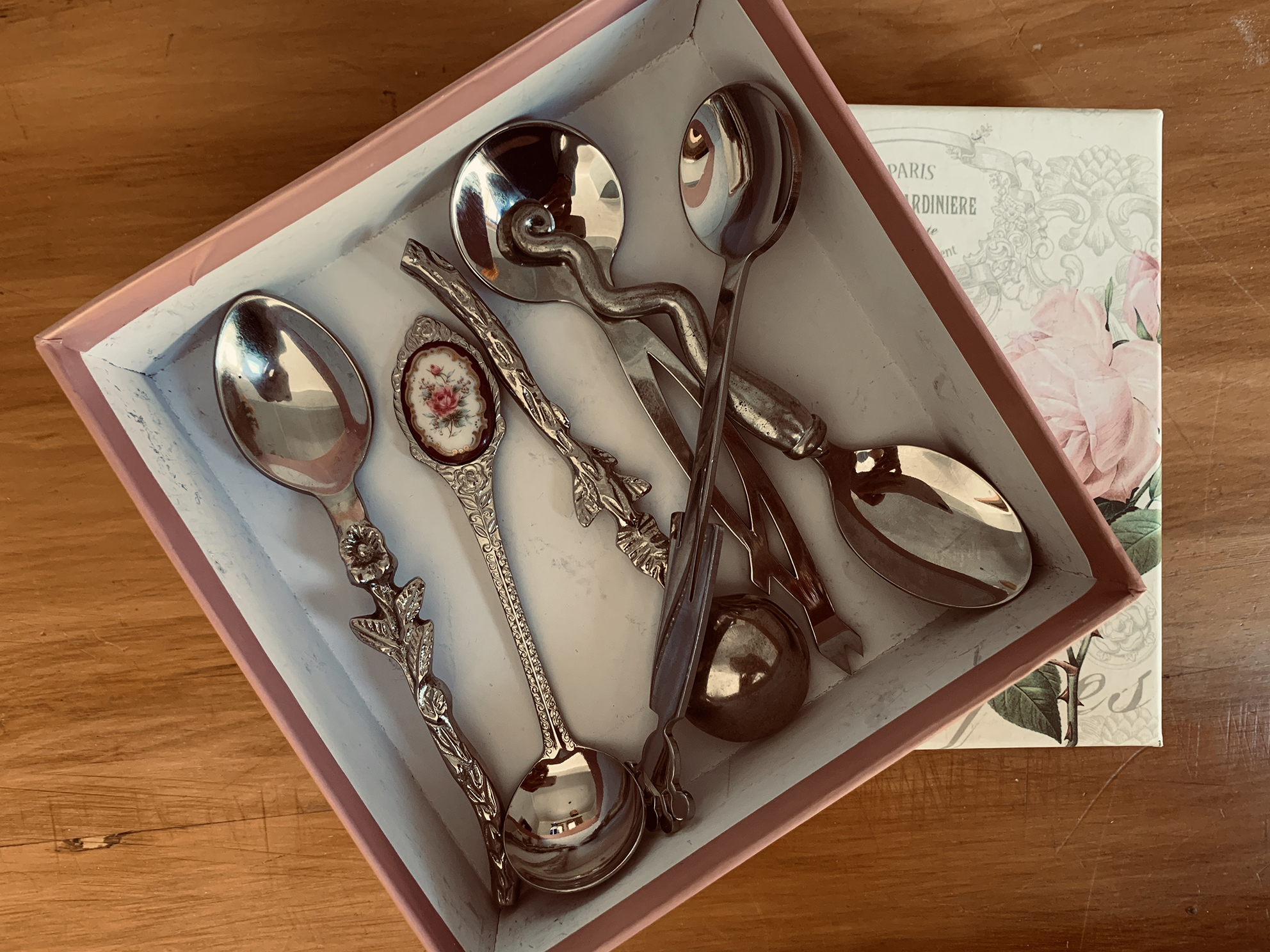
A selection of sugar spoons – large and small, old and new. Photo: Louzel Lombard Steyn
Especially to sugar farmers. The production and processing of sugar cane in the north-eastern parts of KwaZulu-Natal and southern parts of Mpumalanga is big business.
According to the Department of Agriculture, there are approximately 26,400 registered sugarcane growers in South Africa cultivating around 430,000 hectares of cane. More than 25,000 are small-scale growers producing about 10% of the total crop, while a handful of large-scale growers produce approximately 83% of the total sugarcane crop. Some of the big milling companies with their own sugar estates produce the remaining 7%.
A drive through sugar-cane country reveals slopes of green, bamboo-like reeds growing as tall as 2m. It’s not uncommon to see pedestrians snacking on large pieces of reed along the N2. At some of the toll gates, resourceful entrepreneurs have even set up stalls selling the local delicacy to passersby.
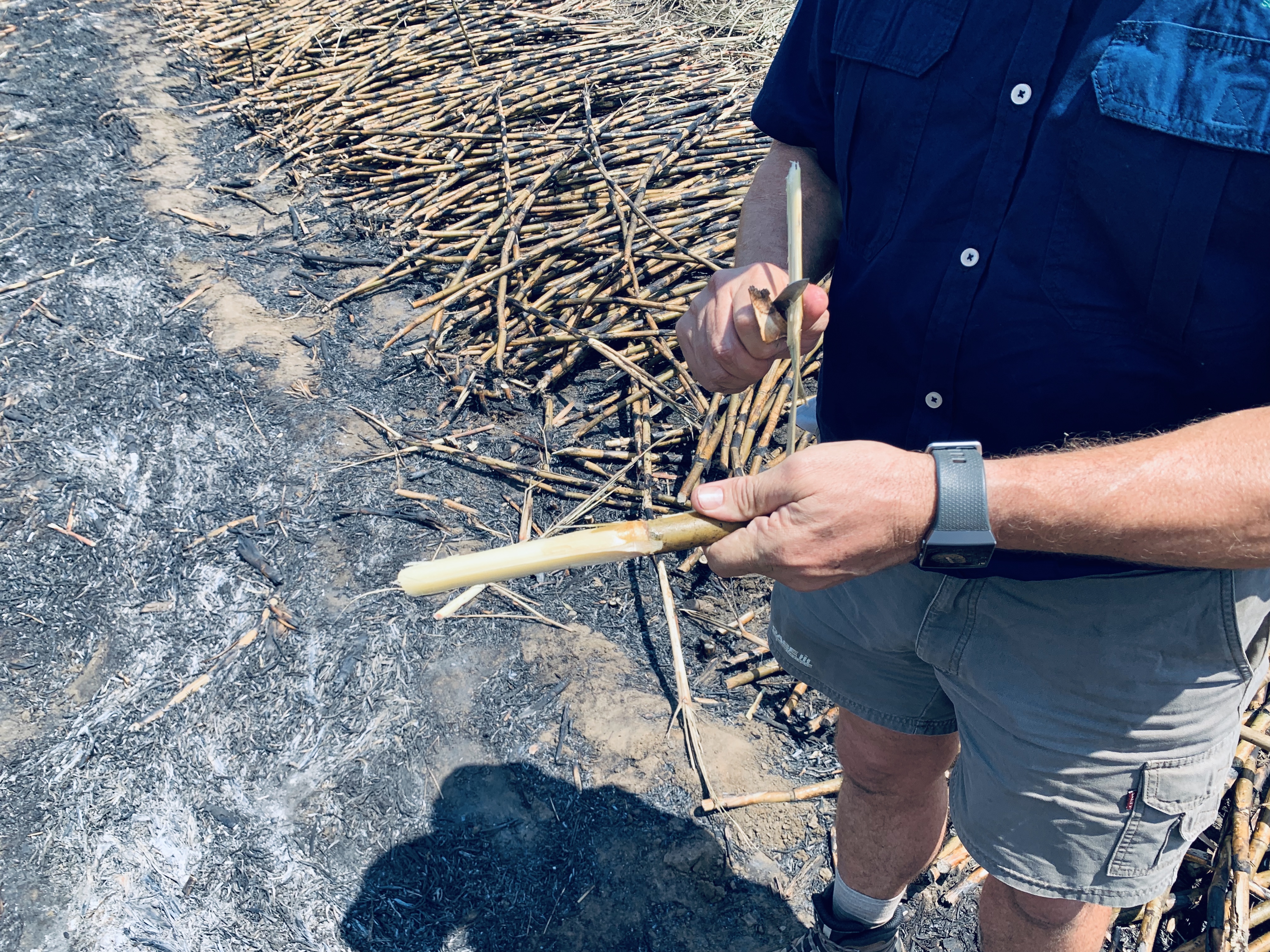
Riaan Durant strips a chunk of cane to expose the sweet fibres inside. Photo: Louzel Lombard Steyn
Raw sugar cane is sweet with an undertone of raw corn produced by the fibrous strands of the reeds’ insides. You have to chew or strip away the bark to reveal the juicy inner-bits, which look almost like a honeycomb drenched in syrup. Like with honey wax, the reeds are also chewed up and spat out as the texture isn’t very palatable.
The reeds that make it to sugar follow a simple production process. When harvested, sugar cane crops are set alight to burn. It seems counterintuitive, but the process quickly and effectively removes all the green leaves on the outsides of the reeds. The moisture of the syrups inside the canes prevents the sugar-containing reeds from burning.
“It’s like throwing a plastic bottle full of water into the fire,” says Riaan Durand from Farmers Agri-Care in Pongola. “The water inside keeps the outer layer and the sugar inside from burning.”
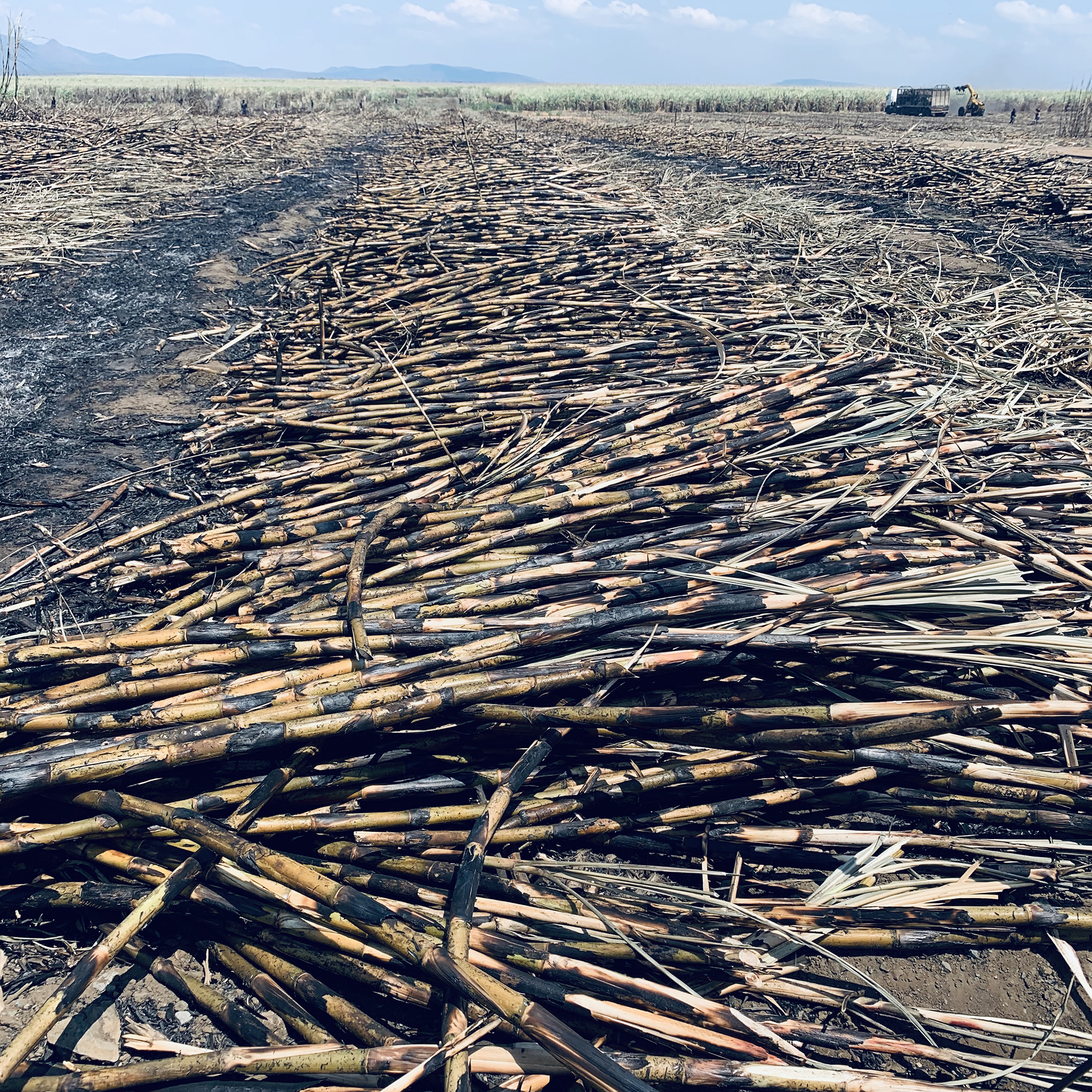
Sugar cane fields are burnt before harvest to strip all the green leaves, fast and effectively. Photo: Louzel Lombard Steyn

After the fire, only the burnt sugar canes are left standing. These are harvested with a sickle before being loaded on a custom-made truck. Photo: Louzel Lombard Steyn
The burnt canes are then harvested with old-school sickles and loaded onto a custom-made truck for transportation to the nearest sugar mill. It’s a messy business; the sugary liquid usually dripping from the sides of the trucks as they drive to the mills. Here, a simple, mechanical chain action sees an entire truckload dumped onto the mill’s receiving platforms in seconds.
At the RCL Sugar Mill in Pongola, KZN, truckloads of cane are brought in from the nearby farmlands to be processed. “All in all, it’s a simple process,” Riaan says. At the sugar mill, the sugar cane stalks are washed and cut into shreds before being pressed by huge rollers to extract the “juice”, which is clarified, concentrated and crystallised before being spun in a centrifuge to remove the liquid and produce golden raw sugar.
These days, sugar also plays a large role in our growing green culture. Many biodegradable takeaway containers are made of sugar rests and the sugar mills often use the rests to fuel the fires to produce the final product.
From raw sugar, the refining process starts. Further filtering and purification via melting removes impurities, like molasses. The sugar liquid is once again crystallised and dried completely as pure refined white sugar.
In April 2018, South Africa became the first African country to impose a tax on sugary drinks. The move was welcomed by the Health Department, trying to rein in the midriffs of 28.3% of the population, declared obese by the World Health Organisation. Children in SA, especially, have shocking sugar habits, the 2016 report found.
But sugar wasn’t always as abundant. Back in the day, sugar was a rare kitchen commodity stored on the highest shelf in the pantry. It was – and still is – used very conservatively South African classics like Milk Tart and pannekoek – a testament to its scarcity when the recipes were initially developed.
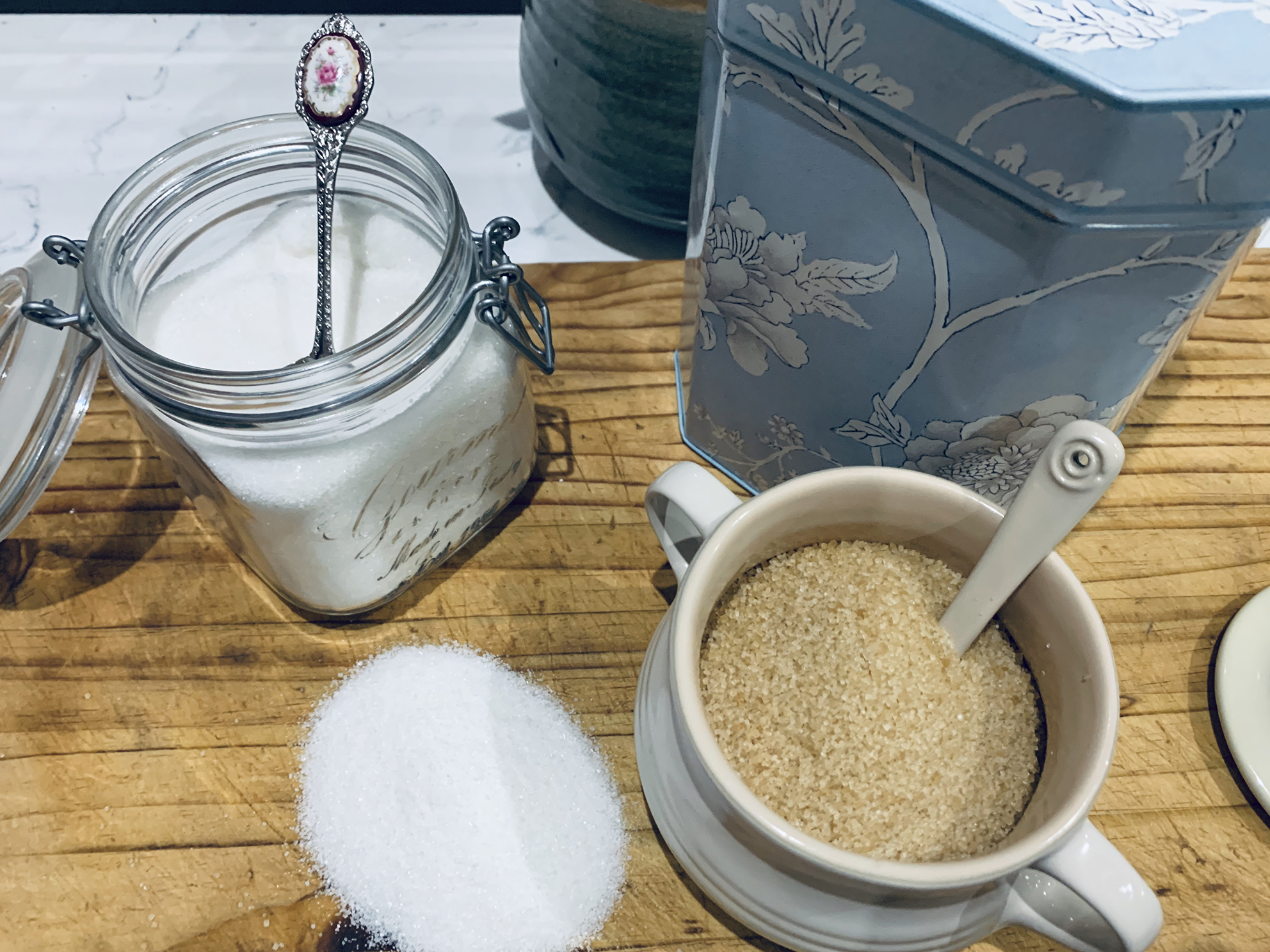
The final product – a kitchen staple. White and brown sugar are consumed daily by the majority of South Africans. Photo: Louzel Lombard Steyn
When sugar was used, it was done so with the utmost care and skill. My great grandmother Ouma Tok was famed for her wedding cake fondant flowers, which she crafted by hand in the exact likeness of their real counterparts. She also made coloured, striped candy cane sticks every festive season, mesmerising us with how she handled the hot, molten substance as if she was moulding glass. And don’t even get me started on the nests of spun sugar she could conjure up out of thin air.
Meringues, however, were her speciality, where she could apply her full understanding of sugar and its temperamental nature.
Few sweets celebrate the essence of sugar as well as meringue. Egg whites with sugar – manipulated to produce airy clouds of sweet delight. If you add the sugar raw, like the French do, a low temperature will melt and bake the sugar without caramelising it to produce pure white, hard-shelled clouds with soft and gooey centres.

Sugar magic: Italian meringue is made by beating a sugar syrup into fluffy egg whites. The hot sugar cooks the egg, creating a very stable meringue that is safe to eat. Photo: Louzel Lombard Steyn
The Italians, again, prefer their sugar precooked when making meringues. Whipping the hot sugar syrup into foamy egg whites doesn’t just make it the most stable of the meringues, it’s also safe to eat without additional baking.
If you take your sugar a little further, to the hard-ball stage, the Italian meringue method can produce nougat – perhaps the greatest sugary miracle of all.
If you understand how it works, sugar can make you a magician… even if it’s just with that extra “bietjie vir liefde” that you add to your loved one’s morning coffee.
If you’re a sugar beginner, try this simple homemade caramel recipe. The key is patience – give the sugar time to dissolve completely before it starts to boil. This way you prevent the risk of crystallisation.
Homemade Salted Caramel Sauce
2 cups white sugar
1 cup fresh cream
2 tsp Maldon Sea Salt Flakes
On a low and even heat source, dissolve sugar in a heavy-based pan. Don’t stir it! Once melted, bring to a boil and caramelise until the sugar is brown in colour. Remove from the heat. Have a whisk at hand. Very carefully, add the cream and start stirring. The moisture will make a big noise in the pan, but just keep stirring until all the lumps are smoothed out and you have your desired consistency. If it looks too runny, it’s ready. The caramel sauce will firm up once you cool it down. Sprinkle over the salt and stir well.
This sauce is great as a topping for ice cream. DM





 Become an Insider
Become an Insider